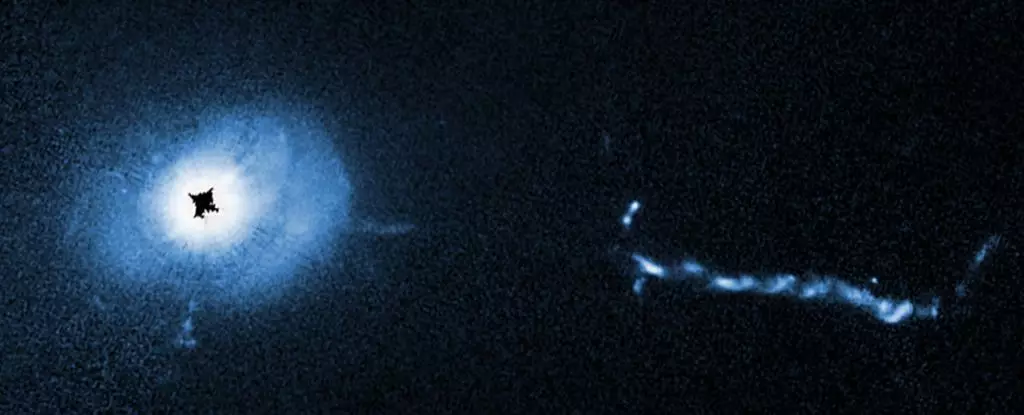In the vast expanse of the universe, quasars stand out as extraordinary celestial objects, illuminating the cosmos with their immense brightness. These enigmatic entities are a particular type of active galactic nucleus, characterized by the presence of supermassive black holes at their centers, relentlessly consuming surrounding matter. Among the myriad of quasars, 3C 273 holds a unique position—not only is it one of the closest quasars to Earth, located approximately 2.5 billion light-years away, but it is also one of the brightest, shining with an intensity that rivals trillions of suns. Recent observations conducted by the Hubble Space Telescope have provided unprecedented insights into this captivating quasar, revealing intricate details about its structure and contributing to our understanding of such luminous phenomena.
The Hubble Space Telescope, renowned for its ability to peer into the depths of space, has once again proven its worth. Using the Space Telescope Imaging System (STIS), astronomers cleverly devised a unique observational technique akin to creating a coronagraph. This method essentially acts as a filter, blocking out the overwhelming glare from the quasar itself, allowing researchers to focus on the surrounding environment. This innovative approach enabled them to capture images that offer eight times more detail than previous observations, revealing structures previously thought to be shrouded in mystery.
Astronomer Bin Ren, representing the Côte d’Azur Observatory in France, expressed excitement about these findings, noting the unprecedented detail in the observations. The ability to visualize structures around 3C 273 offers a fresh perspective and opens new avenues for exploration. By revealing the cosmic landscape surrounding this quasar, astronomers hope to unravel not just the secrets of 3C 273, but also gain insights into quasar behavior in general.
Quasars, often regarded as the brightest objects in the universe, emit light generated by the accretion of material around their supermassive black holes. While black holes themselves remain invisible, the gas and dust spiraling toward them ignite, producing radiant energy across the electromagnetic spectrum. This process, akin to a cosmic furnace, creates a dazzling brilliance as matter approaches the event horizon, illuminating the surrounding area.
The newly collected data on 3C 273 has allowed researchers to take a closer look at specific features within the quasar’s environment. Notable observations included small clumps that may represent satellite galaxies or remnants of material being drawn into the quasar, emphasizing the dynamic interactions occurring in this region of space. Among the most intriguing discoveries was the identification of an L-shaped filament—a feature yet to be fully understood—which highlights the complexity of the processes at play.
One of the standout findings from Hubble’s observations of 3C 273 is the detailed examination of its astrophysical jet—an outflow of particles propelled away from the black hole. Extending an astonishing 300,000 light-years into intergalactic space, this jet offers valuable insights into the mechanics underpinning quasars. Researchers have measured the motion of the jet over a 22-year span, noting a peculiar trend: as it moves further from the black hole, the jet appears to accelerate, suggesting a complex interplay between magnetic fields and relativistic jet dynamics.
Understanding these jets is critical, as they play a significant role in shaping the galactic environment. They can influence star formation, interact with intergalactic mediums, and contribute to the overarching structure of the universe. With Hubble bridging the gap between small-scale radio observations and large-scale optical imaging, astronomers are gaining a more comprehensive view of these phenomena.
The recent observations of 3C 273 serve as a pivotal step in our quest to comprehend quasars—a category of celestial objects that continues to intrigue scientists. The combination of rich data and sophisticated imaging techniques not only enhances our understanding of this particular quasar but also paves the way for future research. As astronomers analyze these findings, they aspire to unravel the intricate relationship between quasars and their host galaxies, probing deeper into the mechanisms that power these cosmic beacons.
The study of quasar 3C 273 exemplifies the transformative impact of advanced observational tools like the Hubble Space Telescope. It highlights the importance of innovative approaches in revealing the complexities of the universe. As he aptly noted, Bin Ren’s assertion that Hubble is bridging gaps in our understanding emphasizes the evolving nature of astronomical research. The universe remains an enigmatic expanse, and with every new discovery, our grasp of its enigmatic intricacies grows ever more profound.


Leave a Reply